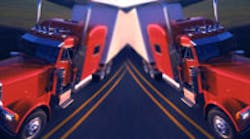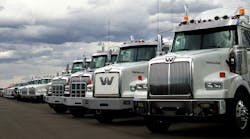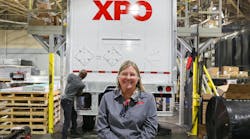A Fork in the Road
With 18 months to go before the EPA's 2010 emissions standards take effect, some real differences are beginning to emerge as engine makers start releasing details on how they intend to meet those standards. On one side, we have proponents of selective catalytic reduction (SCR) technology. On the other, we have those who say they'll go with current cooled exhaust gas recirculation (EGR) technology — just more of it.
Along with the different approaches are sometimes loud arguments about who has the superior technology, stirring up some confusion among fleets and other users. In this report, and in the following installments over the coming months, Fleet Owner will attempt to sidestep the rhetoric and provide you with an objective view of the pros and cons of each approach.
In brief, SCR is an aftertreatment approach that injects a urea-based fluid into the exhaust stream, turning unwanted NOx into nitrogen and water. Advantages should be better fuel economy than even current diesels, less active regeneration of diesel particulate filters (DPFs), and use of a proven technology already working in Europe and Asia. The main disadvantage is that it requires a second tank to hold the urea, which must be refilled periodically.
What's being called the “high cooled EGR” approach doesn't require urea or any additional fluids. It uses current technology to further suppress NOx creation in the combustion process and cleans up the resulting particulate matter (PM) in the DPF. While it avoids the weight, cost and nuisance of urea, there will most likely be a fuel economy penalty.
Which side has the right approach? Both, probably. In the end, it will depend on their execution and your application. On the following pages, you can judge the arguments each engine maker offers for its choice, or choices. And in the coming months, we'll look to put some numbers and other quantifiable analysis behind those expectations.
Caterpillar
Caterpillar has not made a formal announcement concerning its plans for compliance with the 2010 engine emissions standards. However, earlier this spring, Reuters (www.reuters.com) reported that the company was still considering 2010 alternatives, quoting Caterpillar CEO and chairman Jim Owens as saying, “I think it is important, personally, that we find a way to successfully play in the on-highway truck industry. … We have an engine, we sell to all the OEMs, and we have contracts that go out to 2010. But beyond that we have to develop new product technology for the on-highway truck market, and we have to decide how we are going to market with that product. …We could exit. We could partner. We could acquire.”
The company has said that the solution for 2010 will be built off its ACERT Technology platform. ACERT was first introduced in 2003 and updated in 2007 with the addition of Clean Gas Induction — a proprietary process that draws off a small amount of non-combustible gas after it has passed the engine's aftertreatment system, cools it, blends it with more incoming cool air, and returns it to the combustion chamber — and a diesel particulate filter featuring Caterpillar's own Cat Regeneration System (CRS).
View other companies' strategies for meeting the 2010 guidelines




